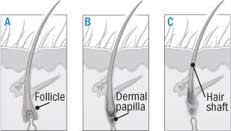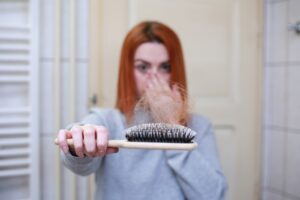
Hair loss can range from mild hair thinning to total baldness. Hair can fall out for many different reasons. Medically, hair loss falls into several categories, including:
- Telogen effluvium — this common form of hair loss happens two to three months after a major body stress, such as a prolonged illness, major surgery or serious infection. It also can happen after a sudden change in hormone levels, especially in women after childbirth. Moderate amounts of hair fall out from all parts of the scalp, and may be noticed on a pillow, in the tub or on a hairbrush. While hair on some parts of the scalp may appear thinner, it is rare to see large bald spots.
- About one-third of women experience hair loss (alopecia) at some time in their lives; among postmenopausal women, as many as two-thirds suffer hair thinning or bald spots. Hair loss in women often has a greater impact than hair loss does on men w, because it’s less socially acceptable for them. Alopecia can severely affect a woman’s emotional well-being and quality of life.
- The main type of hair loss in women is the same as it is men. It’s called androgenetic alopecia, or female (or male) pattern hair loss. In men, hair loss usually begins above the temples, and the receding hairline eventually forms a characteristic “M” shape; hair at the top of the head also thins, often progressing to baldness. In women, androgenetic alopecia begins with gradual thinning at the part line, followed by increasing diffuse hair loss radiating from the top of the head. A woman’s hairline rarely recedes, and women rarely become bald.
- There are many potential causes of hair loss in women, including medical conditions, medications, and physical or emotional stress. If you notice unusual hair loss of any kind, it’s important to see your primary care provider or a dermatologist, to determine the cause and appropriate treatment. You may also want to ask your clinician for a referral to a therapist or support group to address emotional difficulties. Hair loss in women can be frustrating, but recent years have seen an increase in resources for coping with the problem.
Life cycle of a hair

Each hair develops from a follicle — a narrow pocket in the skin — and goes through three phases of growth. Anagen (A), the active growth phase, lasts two to seven years. Catagen (B), the transition phase, lasts about two weeks. During this phase, the hair shaft moves upward toward the skin’s surface, and the dermal papilla (the structure that nourishes cells that give rise to hair) begins to separate from the follicle. Telogen (C), the resting phase, lasts around three months and culminates in the shedding of the hair shaft.
NaturVital’s Anti-Hair Loss range is the most effective way to prevent hair loss and keep it firm and healthy from the roots. Its formulation incorporates natural extracts and avoids the use of synthetic ingredients, with products designed to care for different types of hair and improve the hydration and flexibility of the hair.
Contains Trico serum, a Phytoactive Complex based on Wheat and Soy seeds, Ginseng extract, Pro-vitamin B5 and Vitamins A, B3, B7, E, F and H. It effectively reduces hair loss, strengthens from the roots and does not harm the scalp.
Formulas reinforced with Saw Palmetto and Caffeine extracts.
Invigorate the hair bulb.
Proven Efficiency in clinical studies
Clinical study carried out by the Faculty of Pharmacy of the University of Barcelona.











Leave a reply